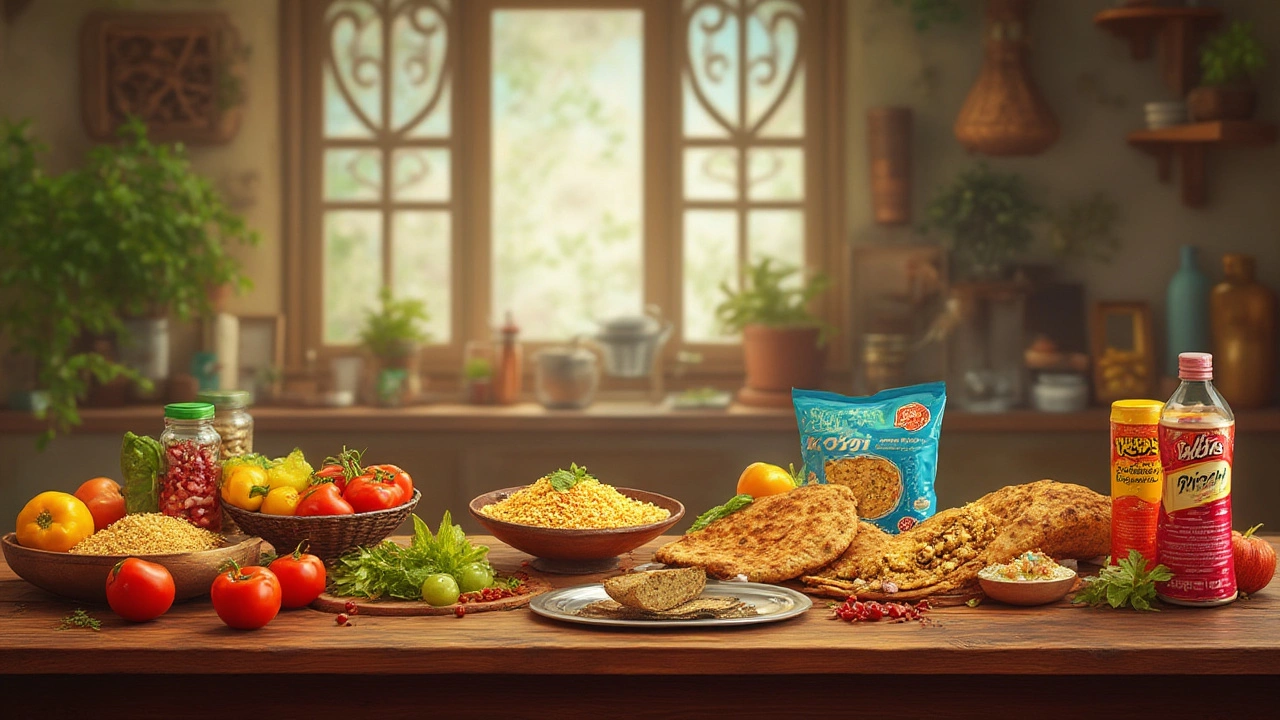You might think all processed foods are equal—lumped in the same group as candy bars or fizzy drinks. But stop and check your kitchen. That pre-cut bag of lettuce? That's technically processed too. Food processing isn’t evil by itself, but the level of processing can totally change a food’s taste, nutrition, price, and even how you store it. Understanding the 4 main levels of food processing gives you real power over your plate. Curious why an apple isn’t the same as applesauce or why a can of tuna isn’t quite like tuna salad? It all comes down to these levels.
Why Food Processing Exists and How It Shapes Our Diet
First, let's bust a myth: Food processing isn’t just big machines churning out synthetic snacks. Humans have processed food one way or another for thousands of years. Early folks sun-dried meat, fermented vegetables, ground grains, and more. Processing helps keep food safe, stretches its shelf life, saves you work, and sometimes even boosts nutrition (think of fermented kimchi or fortified breads). These days, food factories and kitchens use hundreds of techniques, but each one fits within four categories, officially recognized by systems like the NOVA classification. Here’s why this matters: studies show that people eating more highly processed foods tend to get more sugar, unhealthy fats, and salt—even if they’re eating plenty of calories. If you want to avoid nutrition pitfalls without falling into food snobbery, learning these categories helps make smarter choices, not just trendy ones.
Group 1: Unprocessed and Minimally Processed Foods
This first group is basically foods as close to their natural form as possible. Think fresh fruit, raw veggies, whole grains, or cuts of raw chicken or fish. Even if apples are washed, carrots are peeled, or oats are rolled, the essence of the food doesn’t change. These foods can be chopped, crushed, frozen, pasteurized, or vacuum-packed—processing methods meant to preserve, but not to create something completely new. For example, broccoli you find in the supermarket may be trimmed and bagged, but it’s still just broccoli. Similarly, milk that's pasteurized and homogenized is treated for safety but remains milk.
Why does this matter? Because these foods are naturally fuller in vitamins, minerals, and fiber. Diets based on this group are strongly linked to lower obesity rates, less diabetes, and healthier hearts. The catch? These foods can spoil quickly—hence why so many people rely on the next group for convenience. Here are some solid examples:
- Fresh bananas, tomatoes, or sweet potatoes
- Plain yogurt (no added sugar or flavors)
- Bags of washed spinach or chopped lettuce
- Plain, vacuum-packed fish fillets
- Frozen vegetables with no added sauces
If you want to shop more from this category, get familiar with your freezer section, and check date stamps at farmer’s markets to verify freshness.
Group 2: Processed Culinary Ingredients
This group feels a bit trickier, but it’s all about single-ingredient items usually made by processing Group 1 foods. You rarely eat these on their own but use them to cook. Most commonly, salt, oils, sugar, and butter fall here. For example, wheat kernels become flour; olives become olive oil; whole cane becomes brown sugar. Modern food plants use large-scale versions of techniques humans invented centuries ago: pressing, grinding, refining, or milking.
Health-wise, there’s nothing wrong with using these ingredients in moderation. Your body actually needs a little fat and salt for nerve and cellular work, though too much is a dietary red flag. Here's where you might spot Group 2 items in your pantry:
- Vegetable and olive oils
- Pure honey or maple syrup
- Sea salt and regular table salt
- Starches like cornstarch or arrowroot
- Unflavored butter or clarified ghee
- White or brown sugar
Why does this matter for food processing levels? Because combining these ingredients with Group 1 foods is how humans invented everything from home-baked bread to salad dressings. The catch is that some store-bought versions (like margarine or refined syrups) are more processed, so reading labels is your friend.

Group 3: Processed Foods
Now we hit the stage most people picture with the word ‘processed’. But here, it means foods with a short ingredient list, usually mixing a Group 1 food with a Group 2 ingredient (like cheese, canned beans with salt, or fresh bread with a bit of oil). The point is to make foods tastier, safer, or easier to store and use. Here’s a fun stat: bread was one of the earliest processed foods, showing up in ancient Egypt over 6,000 years ago. Now, almost every culture has a bread or cheese that fits in this group.
Examples help clear it up:
- Canned fish or beans in brine (not in thick sauces)
- Cheese (just milk, cultures, salt—not cheese-flavored products)
- Fresh-baked bread using flour, water, yeast, salt (not prepacked snack bread)
- Tofu, made by coagulating soy milk
- Fruit pieces in their own juice or plain yogurt
The big difference? Short ingredient lists, and you can often recognize each one. These foods are solid choices for people in a hurry—think cottage cheese for lunch, a slice of crusty artisanal bread, or roasted peanuts without extra coatings. But check that list! If you see a bunch of additives or sweeteners, the food might jump into the next group.
Group 4: Ultra-Processed Foods
This category gets a lot of press, and for good reason. Ultra-processed foods are designed in factories with ingredients and methods you won’t find in home kitchens. These foods often contain five or more ingredients, including fillers, artificial colorings, preservatives, gums, “flavor enhancers”, and more. It's the category where chips, soda, instant noodles, mass-market cookies, sugary breakfast cereals, and frozen pizzas hang out. Why? Convenience, taste, shelf-life, and profit. A 2022 USDA study found that nearly 60% of calories for adults in the U.S. come from foods in this group.
So what makes something ultra-processed? Here’s your checklist:
- Multiple added ingredients (beyond salt, oil, or sugar)
- Industrial methods like extrusion, molding, deep-frying, or hydrogenation
- Addictive flavors and appealing colors
- Often highly marketed and sold in bright, attractive packages
Is every ultra-processed food bad? Not by itself, but eating too many can crowd out healthier options, pile up hidden sugars and sodium, and even alter hunger signals in the brain. If you want a data snapshot, check this:
| Food Group | % of US daily calorie intake (2022 avg) |
|---|---|
| Unprocessed/Minimally Processed | 29% |
| Processed Culinary Ingredients | 12% |
| Processed Foods | 15% |
| Ultra-Processed Foods | 44% |
Popular examples:
- Soda and energy drinks
- Snack cakes, packaged cookies, and chips
- Instant ramen and flavor packets
- Chicken nuggets, fish sticks
- Commercially frozen meals and pizza
If you want a quick decoding tip at the store: flip the package. The longer the ingredient list, the higher the chance you’re holding an ultra-processed item—and the bigger the need for moderation.
How These Food Processing Levels Impact Daily Choices
Most of us don’t have time or money to eat only fresh food every day, and that’s perfectly okay. The trick is balance. Here are a few real-world tips:
- Fill most of your cart with fresh, frozen, or simply processed items (Groups 1–3)
- Use ingredients from Group 2 to flavor food yourself—skip microwave sauces or instant mix packets
- When choosing something in a package, scan the ingredient list: short and simple signals fewer additives
- Treat ultra-processed foods as treats—for birthdays, busy travel, or emergencies, not everyday staples
If you’re planning meals, try swapping one ultra-processed item for a less-processed equivalent. For example, try homemade popcorn with olive oil instead of microwave bags with flavor packets, or plain yogurt with berries instead of fruity candies. Over time, your taste buds (and health markers) often change for the better.
The food industry isn’t going to ditch processing any time soon—if anything, brands are experimenting with plant-based ‘meat’ and new preservation ways right now. But you hold the final call on what ends up in your pantry and belly. Next time you reach for a snack or prep your dinner, take a second to think: What level did this food start at? The answer could surprise you—and maybe even make you rethink what a healthy, tasty meal really means.






